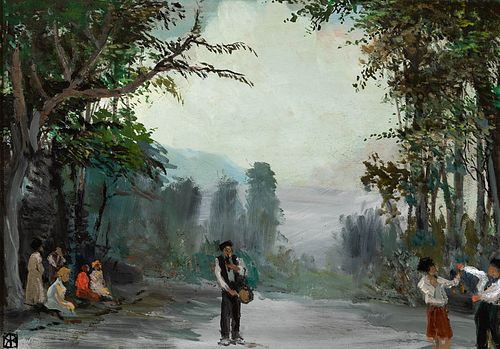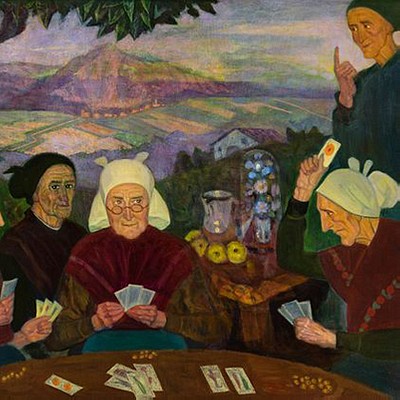RICARDO BAROJA NESSI (Riotinto, Huelva, 1871 - Vera de Bidasoa, Navarra, 1953). "Party", 1949. Oil on panel.
Lot 105
About Seller
Setdart Auction House
Carrer Aragó 346
Barcelona
Spain
Setdart Subastas was born in 2004 and is currently the first online art auction in Spain with solidity, prestige and reliability guaranteed by our more than 60,000 users. Setdart has a young, dynamic and enterprising team ready to successfully manage the purchase and sale of art works through custom...Read more
Estimate:
EUR€8,000 - EUR€9,000
$8,333.33 - $9,375
Absentee vs Live bid
Two ways to bid:
- Leave a max absentee bid and the platform will bid on your behalf up to your maximum bid during the live auction.
- Bid live during the auction and your bids will be submitted real-time to the auctioneer.
Bid Increments
| Price | Bid Increment |
|---|---|
| EUR€0 | EUR€10 |
| EUR€200 | EUR€25 |
| EUR€500 | EUR€50 |
| EUR€1,000 | EUR€100 |
| EUR€3,000 | EUR€200 |
| EUR€5,000 | EUR€500 |
| EUR€10,000 | EUR€1,000 |
| EUR€20,000 | EUR€2,000 |
| EUR€50,000 | EUR€5,000 |
About Auction
By Setdart Auction House
Dec 14, 2021
Set Reminder
2021-12-14 08:00:00
2021-12-14 08:00:00
America/New_York
Bidsquare
Bidsquare : 19th & 20th Century Fine Art
https://www.bidsquare.com/auctions/setdart-auction-house/19th-20th-century-fine-art-7992
Gaudi, Sorolla, Torres Garcia, Maclet, TSUGUHARU FOUJITA, Benjamin Palencia Setdart Auction House sofia@setdart.com
Gaudi, Sorolla, Torres Garcia, Maclet, TSUGUHARU FOUJITA, Benjamin Palencia Setdart Auction House sofia@setdart.com
- Lot Description
RICARDO BAROJA NESSI (Riotinto, Huelva, 1871 - Vera de Bidasoa, Navarra, 1953). "Party", 1949. Oil on panel. Signed with monogram in the lower left corner. Signed with monogram, dated and titled on the back. Work published in "Basque painters and sculptors of yesterday, today and tomorrow", page 80. Measurements: 46 x 65 cm; 66 x 85 cm (frame). The passion that Ricardo Baroja professed for the landscapes of the villages of the interior of Spain, some of them even lost, is demonstrated in the work that concerns us. In the early twentieth century, the Huelva-born artist traveled the country from inn to inn, either for his work as a painter or for his hobby as a hiker. There he immortalized the inn maids and muleteers who transported him, the taverns where he ate and the boarding houses where he stayed overnight. Through his particular technique, agile and swift, Baroja captured like no one else the popular life of the most inhospitable villages of the Spanish territory, championing a unique style tremendously identifiable. Painter, engraver and writer of the Generation of '98, and brother of Pío Baroja, he was self-taught. Developing a style contrary to the aesthetic taste of the artistic juries of the beginning of the century, Baroja took part in the Modern Art Exhibition in Bilbao from 1900 onwards, and exhibited his work in different places, preferably San Sebastian and Madrid. Towards 1900-1906, he focused with dedication on the cultivation of etching, becoming considered the best Spanish master in this field after Goya, standing out from the beginning as a profound portraitist, author of beautiful etchings and scenes of popular life, between Goyaesque and lyrical. At the same time, he dedicated himself to writing. In 1903 he founded, in collaboration with Pablo Picasso and Francisco de Asís Soler, the "Arte Joven" group. In 1928 he was appointed professor at the National School of Graphic Arts. However, as a result of a traffic accident the artist loses an eye and is forced to give up painting, focusing from then on literature. Little by little, he took up brushes again, but he hardly ever painted from life. During the Civil War he lost contact with his brother, who fled to France, and he made a living painting. After the war he continued painting, although only in summer, and writing. In 1940 he again held exhibitions in the art galleries of San Sebastian, Bilbao and Madrid, obtaining great commercial success. In San Sebastian he founds, together with Martiarena, the Artistic Association of Guipuzcoa. In 1952, a year before his death, his success is confirmed with the sale of all his paintings in an exhibition held in San Sebastian. Ricardo Baroja is represented in the Provincial Museum of Lugo, the Fine Arts Museums of Bilbao and Alava, and the San Telmo Museum in San Sebastian, among others.
- Shipping Info
-
In-house shipping available. Please inquire at admin@setdart.com.
-
- Buyer's Premium



 EUR
EUR CAD
CAD AUD
AUD GBP
GBP MXN
MXN HKD
HKD CNY
CNY MYR
MYR SEK
SEK SGD
SGD CHF
CHF THB
THB















